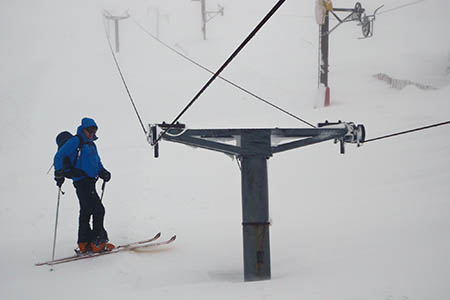A mountain expert is warning hillgoers of the dangers of terrain traps following an unusually large accumulation of snow on the Scottish mountains.
Heather Morning, mountain safety adviser with the Mountaineering Council of Scotland said many walkers and climbers may not be familiar with the term, but they need to be aware of the increased risk of avalanche at these points.
Ms Morning urged mountaineers and skiers to avoid terrain traps with so much snow on the mountains.
The MCofS said a terrain trap is a geographical feature where avalanched snow will accumulate because it has nowhere else to run.
It can be a depression or flattening in the hillside, such as a gully, corrie basin or even an abrupt change in slope angle which would allow avalanche debris to accumulate rather than carry on down the mountainside.
It said: “This winter has been marked by high winds and a continuous rollercoaster of low pressures marching in off the Atlantic, bringing with them high winds and heavy rain.
“High up however, it has been a different story. Above 600m the rain which has been making everyone’s lives a misery has been falling as snow.
Ms Morning said: “If you are lucky enough to see the tops of the mountains on one of those unusual days when the tops are clear, there is an unprecedented amount of snow.
“Ski tows are literally buried.
“These conditions can give some superb days on the hill, and the MCofS encourages folk to enjoy this winter wonderland.
“But everyone must take heed of the potential for avalanche risk.
“Anyone heading out into the hills, whether to climb, walk or ski, should take a close look at the weather forecast and avalanche reports to plan a suitable route.”
Mountaineers also need to be flexible and prepared to change their routes to take account of the conditions. Terrain traps are best avoided if possible.
She said: “An obvious example is Coire na Tulaich on Buachaille Etive Mòr where, sadly, there is a history of people being buried in avalanche debris.
“The key is good route choice. Plan ahead before you leave the comfort of your living room and study the terrain on the map for your intended route.
“Always be flexible and have alternative plans. Stay high – choose ridge lines and broad shoulders.
“In times of high avalanche risk avoid gullies, abrupt slope transitions and corrie basins, and remember: it might not be you that triggers the avalanche, you could just be in the firing line.”
Specialised weather forecasts for the Scottish mountains are available on the Mountain Weather Information Service website and avalanche information and forecasts are on the sportscotland Avalanche Information Service site.
The forecast for the southern Cairngorms for tomorrow predicts a high avalanche risk on northerly aspects above 850m, with cornices prone to collapse and deep, weakly bonded windslab in sheltered features which will avalanche even without human triggering.
